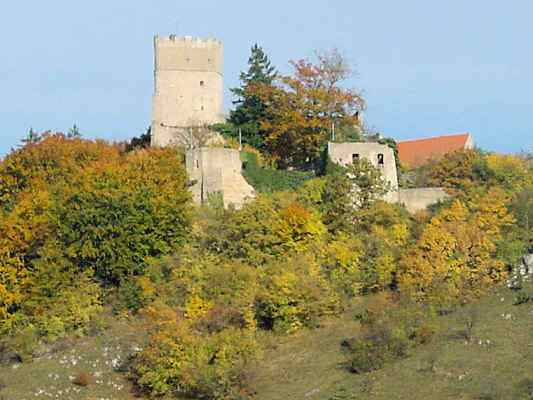
The Castle of Randeck
in Essing in the national park Altmuehl valley
There are no documents about the founding of the castle. It is quite possible that the Celts already had a kind of fortress on the rim of that hill. It was a good place to protect the smithy in Essing, hardly accessible and offering excellent survey.
lt is very probable that in the tenth century Duke Arnulf built the first medieval fortress on the hill in order to protect the land against the raids of the Hungarians.
Baron von Rotteneck is said to have built the castle in the 11th century.
In a document of A. D. 1110, the name of the lord of the manor is mentioned: Henry von Randeck. Members of his family were owners of the castle for some time.
In the 13th century the Counts of Abensberg took possession of the castle; they were the lords of Abensberg and of Randeck. Ulric III, who founded the convent for six prebenciaries and the hospital, died in 1369.
Jack von Abensberg and Randeck was a very outrageous man. From his lookout in the castle he watched the roads and urged the passing merchants to pay a high toll. Everywhere the quarrel-some knight bullied peasants and pestered tradesmen. So the City of Nuremberg finally waged war against him, and the robberknight was overcome. In 1446 his castles were demolished and burnt down. The dungeon was opened where he had kept prisoners who were to starve unless they paid a large ransom.
Niclas, the last Count of Abensberg, was killed in 1485 in a feud with a neighbouring family.
At once Duke Albert the Wise took possession of Randeck and Essing. His son William the Steadfast rewarded his chancellor Leonhard von Eck with Randeck for his faithful services (in 1529). Von Eck was renowned as a man of letters and a wise statesman. He had an inscription written over the door at the draw-bridge:
Nisi dominus custodiat civitatem,
frustra vigilat qui custodit eam.
Unless the Lord keeps watch over the city,
whoever watches will watch in vain.
Eck´s son Oswald also excelled in the humanities and in numismatics. He cooperated with the famous historian Aventinus. In Randeck he collected a real treasure of valuable books, old manuscripts, and coins. In his younger years he was proud of the riches he and his father had heaped. But later he lived to see dearth and poverty.
Towards the end of the 16th century the owner of Randeck was Wolf Freymann, a ducal councillor and a man of great merits. When the Duke of Bavaria gave orders to begin trials for witch-craft in his manorial estate, Freymann dared to resist by reason of humanity and justice and had rather lost his right of jurisdiction than persecuted alleged witches. Later in his life he had to witness the destruction of the castle when the Swedes attacked in the Thirty Years´ War. Both castle and convent were destroyed.
When his son John Freymann was the master of Randeck castle, the inhabitants of Essing rebelled because as bondsmen of the castle they had to groan under enormous drudgery. Obviously ragtag and bobtail had to shoulder the burdens of war and reconstruction. Freymann, however, as a peaceable and indulgent man, did not fight for his rights. He sold the estate.
The new owners were the Jesuits. They engaged a steward who had to live in Essing until the rooms in the castle were sufficlently restored. Valuable pieces - of furniture were transported to Ingolstadt. The steward had to collect taxes and to supervise work on the fields and in the forests. Jurisdiction was with a judge sent from the University of Ingolstadt where the Society of Jesus had overwhelmlng influence.
In 1773 the Society of Jesus was dissolved by the pope. Randeck was first administered by the ducal government and some years later it was given to the Order of Malta. A Commandery of the Order was founded in Essing. In 1803 the order was also dissolved, and the government again became owner of what was left of the once exuberant castle.
The forests were put under the control of the forestry-office in Kelheim ![]() , and so were the hunting-licences. The old buildings, walls and towers were exposed to decay.
, and so were the hunting-licences. The old buildings, walls and towers were exposed to decay.
In 1838 a large part of the castle just collapsed after heavy rainfalls. Barriers were built to protect the houses of Essing against possible damages from falling pieces of the walls of the castle.
When Crown Prince Maximilian was travelling in the Altmuehl valley he was so fascinated with the picturesque ruins of Randeck and with the charming view that he made up his mind to reconstruct what was left and to build a royal castle. An approach ramp was immediately built, and the tower was restored. But in the turmoil of the revolution of 1848 all means were withdrawn and work was stopped. Maximilian, now king of Bavaria, was no longer interested in a new castle. It was enough if further decay was prevented.
back to the Homepage of the town Essing ![]()
Zuletzt aktualisiert am 10.02.2017